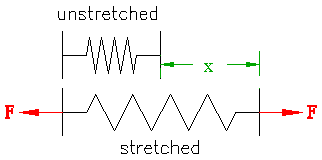
F = kx
| symbol | description |
| F | force |
| k | spring constant |
| x | change in length |
A spring is stretched beyond its unstretched, or relaxed, length by an arbitrary amount x by applying a force with magnitude F at each end. The value x is the difference between the stretched and unstretched lengths. Also, the value of x can be arbitrary, because as long as the spring does not get stretched so far that it becomes permanently distorted, the displacement will always be directly proportional to the force. In other words, for a given spring, F over x will always equal k, whatever the value of x. The 'force constant' or more commonly called 'spring constant' is the constant k. The units of k are in terms of force divided by distance, N/m in SI units or lb/ft in British units.
The stiffer the spring, the greater the value of the spring constant. This makes sense because a stiffer spring means that more force is required to stretch it. Therefore, the stiffer a spring is means that the force is greater for the same change in x. Or, as spring stiffness increases, so does F/x, which equals the spring constant k.